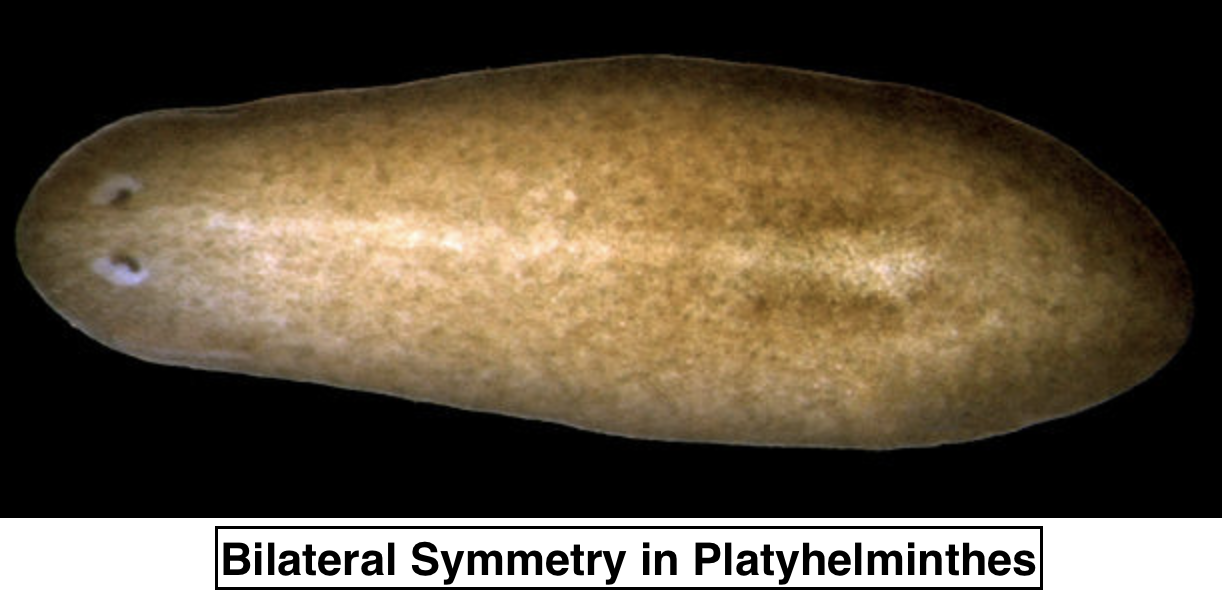
Cephalization is a characteristic mainly associated with which of the following types of body symmetry in animals?
a) Asymmetric
b) Radical
c) Biradial
d) Bilateral
Answer
556.2k+ views
Hint: The body of the animals shows symmetry in the organization. The body plan can be divided into the radial symmetry, bilateral symmetry, and asymmetrical. Only sponges have asymmetry present in them which means they are not symmetrical in their body plans.
Complete answer:
The evolution from the cephalization occurred in the flatworms. In this, the head region was formed with the presence of the sense organs, mouth, nerve ganglia. Over many generations, it led to the formation of a distinct head region of the organism. This was then associated with the bilateral symmetry. It was the first step in the evolution of the head region.

Due to the presence of the head region the animal was easily divided into two equal halves where the left part was identical to the right part. This symmetry helped the organism to have controlled movements in a particular direction.
Additional information: Radial symmetry occurs when the body can be divided into the upper and lower half or can be divided in the form of sun rays. There is no identical part in this symmetry. This is usually found in the cnidarians and Ctenophora. This symmetry helps the organism to move at a very slow pace. Bilateral symmetry is when the body of the organism can be divided into two identical parts. This symmetry helps the organism to move fast around in a particular direction.
So, the answer is ‘d) Bilateral symmetry’.
Note: The bilateral symmetry was formed in the organism due to the evolution that took place. The organisms earlier present didn’t have a distinct head region. The accumulation of the nerves in the head region leads to the formation of a distinct head in the organism.
Complete answer:
The evolution from the cephalization occurred in the flatworms. In this, the head region was formed with the presence of the sense organs, mouth, nerve ganglia. Over many generations, it led to the formation of a distinct head region of the organism. This was then associated with the bilateral symmetry. It was the first step in the evolution of the head region.

Due to the presence of the head region the animal was easily divided into two equal halves where the left part was identical to the right part. This symmetry helped the organism to have controlled movements in a particular direction.
Additional information: Radial symmetry occurs when the body can be divided into the upper and lower half or can be divided in the form of sun rays. There is no identical part in this symmetry. This is usually found in the cnidarians and Ctenophora. This symmetry helps the organism to move at a very slow pace. Bilateral symmetry is when the body of the organism can be divided into two identical parts. This symmetry helps the organism to move fast around in a particular direction.
So, the answer is ‘d) Bilateral symmetry’.
Note: The bilateral symmetry was formed in the organism due to the evolution that took place. The organisms earlier present didn’t have a distinct head region. The accumulation of the nerves in the head region leads to the formation of a distinct head in the organism.
Recently Updated Pages
Master Class 11 Economics: Engaging Questions & Answers for Success

Master Class 11 English: Engaging Questions & Answers for Success

Master Class 11 Social Science: Engaging Questions & Answers for Success

Master Class 11 Biology: Engaging Questions & Answers for Success

Class 11 Question and Answer - Your Ultimate Solutions Guide

Master Class 11 Business Studies: Engaging Questions & Answers for Success

Trending doubts
What is meant by exothermic and endothermic reactions class 11 chemistry CBSE

10 examples of friction in our daily life

One Metric ton is equal to kg A 10000 B 1000 C 100 class 11 physics CBSE

Difference Between Prokaryotic Cells and Eukaryotic Cells

What are Quantum numbers Explain the quantum number class 11 chemistry CBSE

1 Quintal is equal to a 110 kg b 10 kg c 100kg d 1000 class 11 physics CBSE




